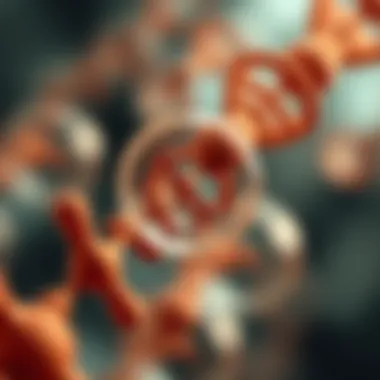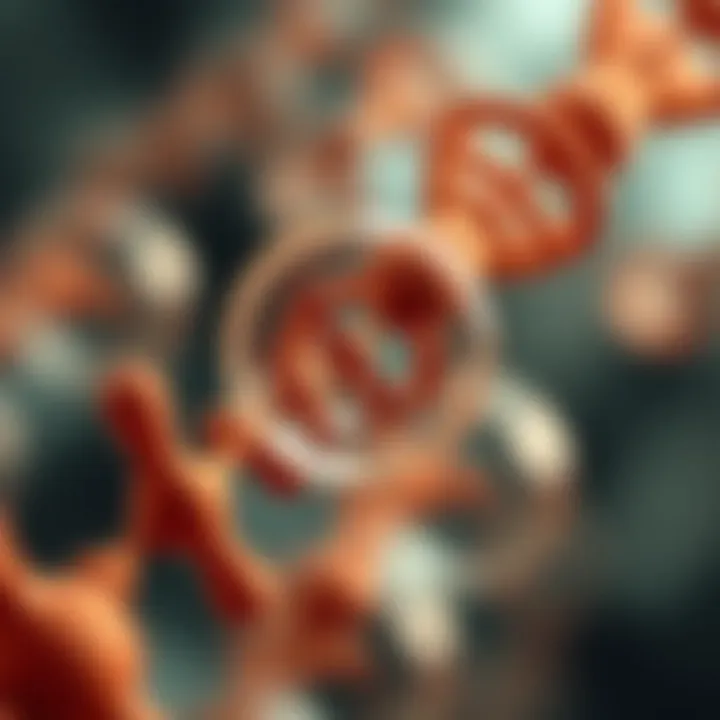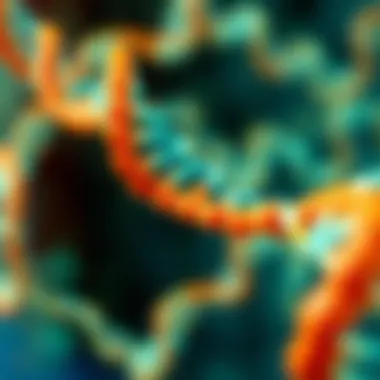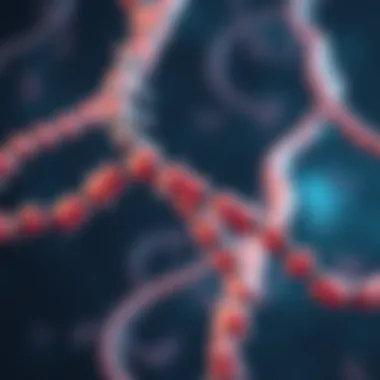DNA Cloning with Plasmid Vectors: An In-Depth Look


Intro
As scientists navigate the complex landscape of molecular biology, one technique stands out for its transformative potential: DNA cloning using plasmid vectors. This method serves as a basic building block of genetic research, enabling researchers to manipulate genetic material in ways that lead to groundbreaking discoveries and innovations across various disciplines, from medicine to agriculture.
DNA cloning, in simple terms, involves copying specific sequences of DNA to create additional identical copies. When combined with plasmid vectors, circular DNA that can replicate independently within a bacterial cell, the possibilities expand significantly. These vectors facilitate the introduction of foreign DNA into host cells, serving as vehicles that carry genetic information into a new cellular environment.
In this exploration, we will journey through the principles behind this technique, the roles plasmid vectors play, and the latest methods applied in today's laboratory settings. By understanding the intricacies of this process, we can appreciate its applications, ranging from the production of insulin to the creation of genetically modified organisms. Connecting theoretical frameworks with practical applications, this article aims to elucidate both the longstanding challenges of DNA cloning and the advancements propelling us toward a new era of genetic manipulation.
Stay tuned as we embark on a thorough examination of DNA cloning with plasmid vectors.
Understanding DNA Cloning
The process of DNA cloning, particularly through the use of plasmid vectors, serves as a fundamental pillar in the realm of molecular biology. Understanding DNA cloning is crucial as it not only provides insights into the manipulation of genetic material but also lays the groundwork for a plethora of advancements in various scientific fields. This section will elucidate specific elements of DNA cloning, unraveling its importance by highlighting its definition, historical background, and its applications which profoundly impact current scientific pursuits.
Definition and Importance
DNA cloning, at its core, refers to the method of making multiple identical copies of a specific DNA segment. This process involves several key steps, ranging from the isolation of target DNA to the insertion of this DNA into a suitable plasmid vector, ultimately allowing the propagation of the genetic material within host organisms. The importance of mastering DNA cloning lies in its wide-ranging applications, whether it's in genetic modifications, pharmaceutical manufacturing, or diverse research initiatives. By providing a way to replicate and analyze genes, cloning creates a cornerstone for further exploration in genetics and biotechnology.
Historical Context
The journey of DNA cloning can be traced back to the advent of recombinant DNA technology in the early 1970s. Scientists, notably Paul Berg, initiated foundational experiments which demonstrated the possibility of combining DNA from different sources. This was soon complemented by the invention of plasmid vectors, primarily by Herbert Boyer and Stanley Cohen, which streamlined the cloning process. Over the years, various techniques have been developed, refining cloning methods and broadening their applications across multiple sectors. Today, such innovations have made DNA cloning a routine procedure within laboratories, revolutionizing both academic research and industrial practices.
Applications in Modern Science
The multifaceted applications of DNA cloning echo its significance in contemporary science. Three notable areas illustrate this integral relationship:
Genetic Engineering
Genetic engineering employs DNA cloning to modify organisms at a molecular level. This technique is pivotal in producing genetically modified organisms (GMOs) that can exhibit desired traits such as pest resistance or enhanced nutritional value. What makes this particularly beneficial is the precision it affords researchers; targeted modifications can be executed with finesse, minimizing unintended side effects. However, the challenge lies in the ethical considerations surrounding GMOs, requiring a balanced approach to harnessing their potential.
Pharmaceutical Development
In the realm of pharmaceutical development, DNA cloning plays a crucial role in the production of therapeutic proteins and vaccines. For instance, insulin, crucial for diabetes management, is now produced using cloned DNA in bacteria, allowing for consistent supply and purity. This aspect of cloning is vital as it not only increases production efficiency but also mitigates the challenges linked with traditional extraction methods from animal sources. Nevertheless, reliance on cloning for drug production can lead to complex regulatory hurdles that need careful navigation.
Research and Development
R&D has seen transformative benefits from DNA cloning, facilitating the exploration of gene functions and interactions. By cloning specific genes, scientists can investigate their roles within cellular processes, shedding light on fundamental biological mechanisms as well as disease pathways. This also encompasses gene therapy approaches, where understanding and altering genetic material can lead to potential cures for hereditary conditions. While the prospects are exciting, researchers encounter hurdles, like ensuring the safety and efficacy of therapies derived from cloned genes.
In summary, Understanding DNA Cloning offers a glimpse into the myriad possibilities held within genetic research, innovation, and industry application. By grasping the underlying principles and historical developments of cloning, one gains a deeper appreciation for its impact and future potential in various facets of science.
Plasmid Vectors: An Overview
Plasmid vectors play a pivotal role in the world of DNA cloning, acting as the carriers that facilitate the introduction of foreign DNA into host organisms. Understanding plasmid vectors not only highlights their importance within molecular biology but also sheds light on the various methodologies that can be harnessed to manipulate genetic material. This insight can streamline workflows in genetic engineering, pharmaceutical production, and other essential research applications.
Characteristics of Plasmids
Size and Structure
Plasmids are typically circular, double-stranded DNA molecules, their size can vary significantly from a mere few thousand base pairs to over a hundred thousand. A key feature of plasmids is their relatively small size, which makes them particularly advantageous for cloning. Smaller vectors can be manipulated more easily and tend to have higher transformation efficiencies when introduced into host cells.
One common type of plasmid structure is the low-copy number plasmid that ensures stability during cell division, while high-copy number varieties enable a greater yield of the desired cloned DNA. However, with smaller size, comes a certain limitation; it often restricts the amount of foreign DNA that can be inserted. Balancing these sizes is crucial, as it can impact the overall cloning success and the expression of the inserted gene.


Replication Mechanisms
The ability of plasmids to replicate independently from the chromosomal DNA of the host cell is another significant characteristic that makes them indispensable in DNA cloning. Plasmids employ various mechanisms for replication, such as theta replication and rolling circle replication. The widespread presence of origins of replication provides a reliable system that allows plasmids to be copied as the cell divides, ensuring that each daughter cell receives a copy of the plasmid.
A unique feature of plasmid replication is its relatively fast turnaround time. This rapid replication rate contributes to the efficacy of plasmid vectors in research and therapeutic applications. However, one should also consider the potential downsides; if plasmids replicate uncontrollably, it could lead to a burden on the host cell, sometimes affecting its viability or productivity.
Types of Plasmid Vectors
Natural Plasmids
Natural plasmids, often found in bacteria, are crucial for horizontal gene transfer and play significant roles in antibiotic resistance and virulence. They are generally easy to isolate and can be a source of genetic information needed for cloning experiments. One key characteristic is their ability to adapt to various environments, which can be a game changer in genetic studies. This adaptability is beneficial because it allows researchers to explore diverse genetic pathways and interactions.
The downside, though, lies in their potential for carrying undesirable genes, which might complicate specific cloning projects. Researchers must exercise due diligence in purifying these plasmids to prevent contamination.
Synthetic Plasmids
Synthetic plasmids represent a leap forward in genetic engineering, neatly combining elements from various sources. They can be designed with enhanced functionalities — like selective markers and promoter sequences tailored for specific applications. One primary advantage of synthetic plasmids is their customization, which allows for tailored solutions to particular cloning challenges. This is invaluable for researchers looking to push the boundaries of gene expression systems.
On the other hand, synthetic plasmids may require more resources and expertise to design and produce, stemming from their complexity compared to traditional natural plasmids.
Expression Vectors
Expression vectors are specialized plasmid vectors designed for the robust production of proteins. They incorporate promoter regions that ensure high transcription levels of the inserted gene, leading to elevated protein yields. This attribute makes them ideal tools in biotechnology for producing therapeutic proteins or enzymes.
A notable characteristic of expression vectors is their inclusion of regulatory elements that counteract the host organism's transcriptional and translational bottlenecks. However, while they provide a higher output, these vectors can also be finicky; the host's cellular machinery must be compatible with the stress of overproduction, which sometimes can lead to misfolded proteins being produced.
The intricate balance of characteristics within plasmid vectors is crucial for successful DNA cloning and ultimately contributes to the advancement of genetic research. As the field progresses, understanding these nuances will be key to navigating the complexities of molecular biology.
The DNA Cloning Process
Understanding the DNA cloning process is crucial as it is the framework for manipulating genetic material effectively. This section unpacks the intricacies involved, which can lead to improved methods and applications in molecular biology. DNA cloning doesn’t just allow scientists to create multiple copies of a segment of DNA, it also enables researchers to purify DNA for further investigation and use in various applications, ranging from genetic engineering to therapeutic developments.
Considerations surrounding the DNA cloning process involve accuracy, efficiency, and the ethical implications of replicating specific genetic sequences. The forthcoming subsections detail the crucial steps in this transformative process.
Isolation of Target DNA
Cotton-Based Methods
Cotton-based methods serve as one of the popular techniques employed for the isolation of target DNA. The standout feature here is the convenient and gentle nature of these methods. Using cotton can yield high-quality DNA, which remains uncontaminated by proteins and other cellular debris. Moreover, the use of disposable materials minimizes the risk of cross-contamination, substantially increasing the reliability of the results.
The primary benefit of cotton-based methods lies in their adaptability. They can be easily modified to suit different extraction protocols depending on the source of DNA, whether it's plant, animal, or bacterial material. However, the downside is that these methods may not always be as high-yield as more aggressive extraction techniques.
Enzymatic Digestion
Enzymatic digestion, on the other hand, involves using specific enzymes to selectively break down cellular components and liberate DNA. The key characteristic here is precision. By targeting particular molecular bonds, enzymes can leave the DNA intact and purify it through various solutions. Such specificity makes enzymatic digestion a favorable choice for researchers looking to isolate high-molecular-weight DNA for cloning.
A unique feature of this method is the variety of enzymes available, which cater to different types of DNA and cell materials. They allow for the extraction of DNA in ways that are tailored to the specific research goals. However, enzymatic digestion requires a careful optimization of conditions, such as temperature and pH, to prevent degradation of the target DNA.
Preparation of Plasmid Vector
Restriction Enzyme Digestion
The preparation of plasmid vectors often begins with restriction enzyme digestion, which cuts DNA at specific sequences, allowing for the insertion of additional genes or sequences. This method is valuable due to its ability to create defined ends, enabling more reliable ligation with the target gene. One of its most appealing aspects is the high level of control it offers researchers in selecting the sites of cleavage, which is pivotal for successful cloning.


However, it is important to note that selecting the right restriction enzymes can be a double-edged sword. While it provides versatility in cloning design, the potential for star activity—where enzymes cut at unintended sites under certain conditions—poses a significant risk of mismatched sequences that could derail cloning efforts.
Vector Linearization
Following the digestion with restriction enzymes, vector linearization is the next step. It entails converting circular plasmids into a linear form to facilitate the ligation of the target DNA fragment effectively. The important aspect of this process is that it provides optimal compatibility for binding the new gene, an absolute requirement for successful cloning.
A distinct advantage of vector linearization is the increased likelihood of success in ligating new DNA, through maximizing the available ends for joining. However, care must be exercised during this phase because too much linearization can compromise the integrity of the plasmid, potentially leading to failure in transformation.
Ligation of DNA Fragments
Enzyme Ligation
Enzyme ligation is the third step wherein the fragmented DNA pieces are joined together. This part of the process relies on ligases, enzymes that catalyze the formation of phosphodiester bonds, thus seamlessly joining the strands. The most significant benefit of enzyme ligation is its specificity and efficiency—it ensures a high-frequency yield of recombinant plasmids when conditions are optimized.
A unique aspect of this method is that it has a relatively straightforward protocol, making it a go-to in most standard laboratory settings. However, achieving the ideal molar ratios of vector to insert can vary, demanding a balanced approach to maximize transformation efficiency without incurring excess background noise from unligated fragments.
Self-Ligation Challenges
While ligation is a crucial step, self-ligation challenges can emerge if the vector has not been appropriately cut. Incomplete restriction digestion or the presence of compatible ends could lead to the undesired cloning of the vector itself rather than the target DNA. The primary concern here is the dilution of the transformation efficiency when self-ligation happens.
Moreover, employing methods to mitigate self-ligation can be an added layer of complexity. This typically involves manipulating the concentration of DNA or using phosphatases to dephosphorylate vector ends, posing a new set of challenges that require precise handling.
Transformation into Host Cells
Methods of Transformation
Transformation methods range widely, but each plays a pivotal role in introducing the newly formed plasmid into host cells. Techniques such as heat shock and electroporation are widely recognized for their effectiveness. A key characteristic of heat shock, which uses a rapid temperature shift, is its relative simplicity, allowing for the quick uptake of DNA by competent cells. It’s particularly beneficial when working with E. coli strains.
The clear advantage of this method is that it is low-cost and rapid, however, it often results in lower transformation rates when compared to electroporation, which can increase electrical permeability of cell membranes. Yet, electroporation demands specialized equipment, making it less accessible for some laboratories.
Selection of Transformants
Once the transformation process is executed, the selection of transformants becomes crucial. This involves using selection markers, typically antibiotic resistance genes, ensuring only those cells that have successfully incorporated the plasmid survive on selective media. The primary reason this step is critical is that it helps to easily identify which cells have taken up the plasmid, eliminating the rest.
This unique feature of using selective markers has proven highly effective; however, it does present ethical dilemmas concerning antibiotic use and resistance. The consideration of convenience versus implications for broader societal health shapes ongoing discourse around cloning and transformation methodologies.
Verification of Cloning Success
Verification of cloning success is crucial for any research involving DNA cloning using plasmid vectors. Ensuring that the cloned DNA is not only present but correctly integrated into the plasmid is a fundamental step that adds an additional layer of validation to scientific endeavors. This aspect serves as the gatekeeper before moving further into extensive experimental applications. If the cloning process isn't verified adequately, downstream applications like expression studies or functional assays might face complications, resulting in wasted resources and time.
Among the core benefits of successful verification are the minimization of errors in subsequent research and the confidence it instills in the experimental outcomes. Researchers can rely on verified clones to produce consistent results across various applications. This verification establishes a solid foundation for the research, allowing scientists to approach the next stages with assurance about the integrity of their materials.
Screening Techniques
Colony PCR
Colony PCR is a method that accelerates the verification process of cloned DNA. Unlike traditional PCR that requires extensive pre-isolation of plasmid DNA, colony PCR allows researchers to directly screen colonies of transformed bacteria for the presence of the target insert. This method is particularly efficient as it bypasses the lengthy purification steps involved in isolating plasmid DNA for analysis.
One of the key characteristics of colony PCR is its speed; results can often be obtained within a matter of hours. Because of its simplicity and effectiveness, it is a go-to choice for many researchers in the initial screening phase after transformation.
A unique feature of colony PCR lies in its ability to screen multiple colonies simultaneously, significantly increasing throughput. However, it does have its disadvantages. False negatives can occur if the amplification is not efficient or if there are inhibitory substances in the bacterial colony. So, while colony PCR is fast and convenient, the results must be corroborated with further testing.
Restriction Analysis


Restriction analysis provides a reliable approach to verifying whether the DNA insert has been successfully incorporated and is of the correct size. This technique utilizes restriction enzymes, which cut DNA at specific sequences, allowing for the characterization of the plasmid. By comparing the banding patterns obtained from gel electrophoresis, researchers can determine the presence and size of the insert.
One significant characteristic of restriction analysis is its precision; it not only verifies that the insert is present but also confirms its size. This level of detail makes it a solid choice for researchers who need comprehensive proof of successful cloning.
The unique advantage of restriction analysis lies in its ability to provide clear-cut information. However, it does come with its downsides. The requirement for specific restriction sites in the vector and insert can sometimes limit cloning options, and multiple digestion steps can be time-consuming. Still, many scientists find that the benefits of confirming the size and presence of inserts outweigh these inconveniences.
Sequencing for Confirmation
Sequencing stands out as the gold standard for verifying cloning success. This method goes a step further than both colony PCR and restriction analysis by providing the actual nucleotide sequence of the insert. This confirmation eliminates any ambiguities regarding size or presence and ensures the integrity of the cloned DNA.
While this method demands higher resources and longer turnaround times than others, its precision makes it invaluable. Sequencing allows detailed comparisons with reference sequences, enabling the identification of any mutations or alterations that may have occurred during the cloning process. In summary, the verification of cloning success through these various methods is essential for ensuring that the research can proceed on solid footing, ultimately enhancing the reliability of molecular genetics studies.
Challenges Faced in DNA Cloning
When exploring DNA cloning, understanding the challenges involved is crucial. These hurdles can affect not only the efficiency of cloning processes but also the integrity of the results. Tackling these challenges directly contributes to improved methodologies and better outcomes in scientific research. By identifying specific issues, researchers can refine techniques and develop innovative strategies.
Contamination Risks
Contamination is one of the most significant threats during the DNA cloning process. It can arise from various sources: environmental factors, reagents, equipment, or even the personnel conducting the experiments. A tiny amount of foreign DNA can skew results, leading to inaccurate conclusions and costly delays. Minimizing contamination risks involves adopting vigorous sterile techniques, which include using sterile equipment and reagents, along with maintaining clean working environments.
Moreover, different cloning processes can have unique contamination vulnerabilities. For example, amplification procedures can inadvertently introduce contamination during PCR (Polymerase Chain Reaction). To combat this risk, rigorous protocols such as the use of negative controls and dedicated areas for preparation can be instrumental in ensuring that clean samples remain uncontaminated.
Incompatibilities Between Host and Vector
Another pervasive issue that cloning professionals encounter is the incompatibilities between host cells and vector systems. Each plasmid vector has its own distinct features that determine its compatibility with different host organisms. The lack of matching factors, like replication initiators or promoters, can cause poor expression of the cloned DNA or, in some cases, complete failure to propagate it.
Take, for instance, the use of E. coli as a host, which is widely favored due to its rapid growth and ease of manipulation. However, if a plasmid vector is introduced into a specific E. coli strain that lacks the necessary traits for its maintenance, the cloning attempt might fall flat. To navigate this challenge, researchers must choose vectors carefully, matching them with host systems that provide the biological requisites for successful cloning.
Low Transformation Efficiency
Transformation efficiency is another key factor that affects the success of DNA cloning. This refers to the ability of a host cell to take up the plasmid vector, with transformations often yielding less than desired results. Various parameters influence transformation efficiency, including the method of transformation, the quality of plasmid preparation, and the conditions of the host cells.
Typically, methods like heat shock or electroporation are employed, yet they often vary in effectiveness. For example, while electroporation generally yields higher transformation rates for certain plasmids, it can also be resource-intensive.
As plasmid integrity is crucial, researchers must pay attention to purification methods, ensuring that they do not compromise the DNA during preparation. It’s often a balancing act, blending experience with innovation to find the most efficient methods.
By addressing these challenges—contamination risks, incompatibilities between host and vector, and low transformation efficiency—researchers can refine their cloning techniques and contribute to the reliability of genetic engineering as a whole. This continual evolution in methodologies not only advances scientific knowledge but also enhances practical applications across different sectors.
Future Directions in DNA Cloning
The field of DNA cloning is continuously evolving, driven by advancements in technology, methodologies, and ethical considerations. Understanding these future directions is crucial because they shape how researchers approach genetic engineering and its applications in society. In the coming years, the integration of emerging technologies promises to revolutionize our understanding and manipulation of genetic material, paving the way for innovative practices and applications that were once thought to be mere science fiction.
Emerging Technologies
CRISPR and Genome Editing
CRISPR technology represents a significant leap forward in the ability to edit genes with precision. This system, derived from a bacterial defense mechanism, allows scientists to make targeted changes to DNA with relative ease. One standout feature of CRISPR is its simplicity. With the right guide RNA, researchers can locate and edit specific genes, making it a popular choice for modifying organisms.
The advantages of CRISPR are clear: it is cost-effective, time-efficient, and versatile. It has been implemented in a wide range of organisms, from bacteria to plants to animals. Nonetheless, there are potential disadvantages to consider. Off-target effects, where unintended parts of the genome are altered, could lead to unforeseen consequences in biological systems. The ethical implications surrounding its use, particularly in humans, remain a point of intense debate.
Next-Generation Sequencing
Next-Generation Sequencing (NGS) provides a powerful tool for understanding genetic material with an unprecedented depth of detail. This method allows for the rapid sequencing of entire genomes, enabling researchers to glean insights into genetic variation and function. What makes NGS appealing is its throughput; it enables the simultaneous analysis of numerous DNA fragments, significantly speeding up the research process.
One unique feature of NGS is its ability to provide data on the entire genome, as opposed to targeting specific regions. This broad approach can lead to discoveries of mutations and variations relevant to disease, evolution, and genetic traits. The downside, however, can be the overwhelming amount of data generated, which necessitates sophisticated bioinformatics tools for analysis. Moreover, as with CRISPR, ethical concerns arise regarding data privacy and the implications of gaining insight into sensitive genetic information.
Ethical Considerations
The rapid pace at which DNA cloning technology is advancing raises a host of ethical questions that demand careful consideration. The capability to edit genes carries with it responsibilities that researchers and society must collectively address. Issues such as consent, especially in the case of germline modifications, must be navigated with caution. Additionally, the potential for misuse of these technologies heightens ethical scrutiny. As a result, ongoing dialogue among scientists, ethicists, and policymakers will be essential in shaping a future that harnesses the benefits of DNA cloning while minimizing its risks.







